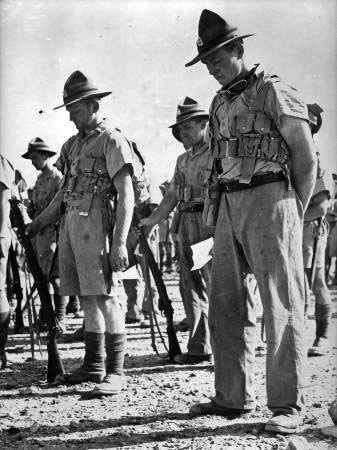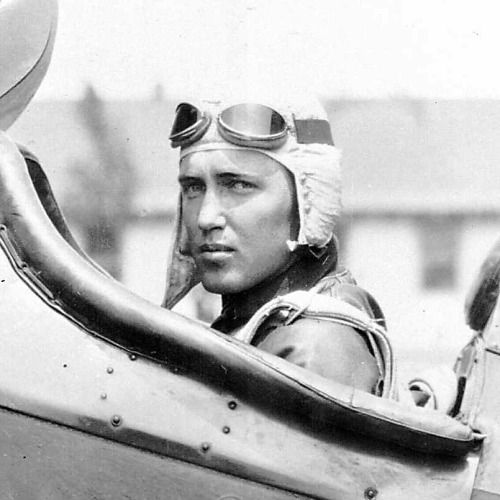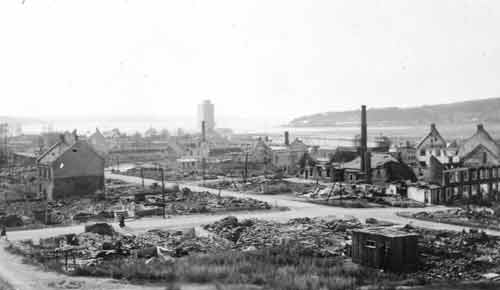Norway: German Foreign Minister Joachim Ribbentrop makes an address on 27 April 1940 about recent diplomatic events. He justifies Operation Weserubung due to a conspiracy of Germany's enemies in Norway, which includes not only the Allied powers but Norway itself. The conspiracy, he claims, is proved by documents in his possession showing that the British intended to invade Norway. Tellingly, he does not even mention Denmark.
With lightning speed for diplomatic relations, British Air Minister Sir Samuel responds to Ribbentrop's speech the same day:
The British War Cabinet discusses a potential evacuation from Norway. Reports from the field are increasingly dire. General Hugh Massy, Deputy Chief of the Imperial Staff, reports to the Military Coordination Committee (MCC), led by First Lord of the Admiralty Winston Churchill (in PM Chamberlain's absence), that an evacuation is advisable. The MCC "agreed that the evacuation was to take place." In the chain of events leading to formal approval of the evacuation, this is the key link.
King Haakon is quoted in today's "The War Illustrated": "I will stay as long as there is 1 inch of Norwegian soil." General Ruge continues his optimistic line in his order of the day: "The time for retreating is past! Stand fast- and victory shall be ours!"
German-controlled Oslo radio announces that there now exists a state of war between Germany and Norway. Apparently, the mission is no longer to just protect Norway from the British. This causes some amusement in Norwegian circles, but also some trepidation at what else the Germans might be capable of doing.
Norway Army Operations: At Åndalsnes, port commander Brigadier Boggs reports that the situation is hopeless without air cover or anti-aircraft batteries. There is great disagreement about this within the British military, and General Paget, Boggs' superior, violently disagrees because his troops are fighting well.
Paget's 15th Brigade troops at Kjorem in the Gudbrandsdal hold out throughout the day, then make an orderly withdrawal 17 km north to a fortified line at Otta.
To the east, near the Swedish border, the other main Wehrmacht thrust north in the Østerdal valley, Oberst Fischer’s Kampfgruppe composed of the 196th Division, makes good progress. They are now at Alvdal, within 60 miles of the key road/rail junction of Dombås. The capture of Dombås would effectively encircle the 15th Brigade, and there are few troops to bar the way.
The French 27th Demi-Brigade de Chasseurs Alpins takes up positions at Harstad near Narvik.
Norway Naval Operations: The British transfer the light cruiser HMS Calcutta from Namsos to Åndalsnes to replace the damaged HMS Curacoa, which has been escorted back to England. This helps the air defense of Åndalsnes at the expense of Namsos. Admiral Forbes, Commander-in-chief of the Home Fleet onboard HMS Rodney, recommends using the RAF and land batteries for air protection due to risk and logistical problems. His recommendation is disregarded as the higher commands begin to accept the idea of evacuation.
Norwegian Air Operations: It is a time for decisions as to how much effort to give Norway. Squadron Leader Ian Cross flies to Åndalsnes in a Sunderland flying boat and reports to the Air Ministry that Hawker Hurricanes could operate from Setnesmoen near Åndalsnes and recommends their immediate deployment. The Air Ministry, with knowledge of the MCC decision to evacuate, rejects the suggestion.
The three remaining Gloster Gladiators at Andalsnes have been destroyed and there is no local air cover.
The Luftwaffe bombs a Royal Navy supply convoy as it approaches Åndalsnes. The attack forces the convoy, which is carrying anti-aircraft batteries, to turn away.
German Military: Hitler, "beaming with confidence" while contemplating events in Norway, tentatively sets the date for Fall Gelb, the invasion of France and the Low Countries, for May 7th.
Battle of the Atlantic: The Luftwaffe sinks British freighter Galena in the English Channel.
Convoy OA 137 departs from Southend.
Destroyer USS Walke (Lt. Commander Carl H. Sanders, Jr.) is commissioned.
U-102 (Kapitänleutnant Harro von Klot-Heydenfeldt) is commissioned.
British Military: The government lowers the age for military registration from 27 to 26.
Latin America: The Inter-American Neutrality Committee meets in Rio de Janeiro.
New Zealand: More troops embark for Egypt.
War Crimes: In 29 days, Vasily Blokhin has shot over 7,000 Polish officers interned at the Ostashkov prisoner of war camp as part of the Katyn Forest Massacre. Today, he is given a medal for it, the Order of the Red Banner for his "skill and organization in the effective carrying out of special tasks."
Holocaust: Reichsfuhrer-SS Heinrich Himmler orders the construction of Auschwitz at the Silesian town of Oswiecim in Poland. The Germans have changed the name of the location to "Auschwitz."
Future History: Vasily Blokhin of Katyn Forest Massacre fame achieves immortality long after his death in 1955 when the Guinness Book of World Records names him "Most Prolific Executioner" in 2010.
April 2, 1940: British Subs On Alert
April 3, 1940: Churchill Consolidates Power
April 4, 1940: Missed the Bus
April 5, 1940: Mig-1 First Flight
April 6, 1940: Troops Sailing to Norway
April 7, 1940: Fleets At Sea
April 8, 1940: HMS Glowworm and Admiral Hipper
April 9, 1940: Invasion of Norway
April 10, 1940: First Battle of Narvik
April 11, 1940: Britain Takes the Faroes
April 12, 1940: Germans Consolidate in Norway
April 13, 1940: 2d Battle of Narvik
April 14, 1940: Battle of Dombås
April 15, 1940: British in Norway
April 16, 1940: Germans Cut Norway in Half
April 17, 1940: Trondheim the Target
April 18, 1940: Norway Declares War
April 19, 1940: Dombås Battle Ends
April 20, 1940: Germans Advancing in Norway
April 21, 1940: First US Military Casualty
April 22, 1940: First British Military Contact with Germans
April 23, 1940: British Retreating in Norway
April 24, 1940: British Bombard Narvik
April 25, 1940: Norwegian Air Battles
April 26, 1940: Norwegian Gold
April 27, 1940: Allies to Evacuate Norway
April 28, 1940: Prepared Piano
April 29, 1940: British at Bodo
April 30, 1940: Clacton-on-Sea Heinkel
2019
With lightning speed for diplomatic relations, British Air Minister Sir Samuel responds to Ribbentrop's speech the same day:
I need only to say that it is a despicable to say that we have ever plotted against any neutral country and it is sickening hypocrisy when this charge is made by the murderer of Czechoslovakia and Poland.The truth lies somewhere in between. The British have not "plotted against" Norway, for sure, because they strenuously sought the country's approval prior to landing an expeditionary force. However, the British and French also very much intended at various points to occupy at least parts of Norway - and Sweden. Those reasons were decidedly inimical to the military interests of their adversary, Germany.
The British War Cabinet discusses a potential evacuation from Norway. Reports from the field are increasingly dire. General Hugh Massy, Deputy Chief of the Imperial Staff, reports to the Military Coordination Committee (MCC), led by First Lord of the Admiralty Winston Churchill (in PM Chamberlain's absence), that an evacuation is advisable. The MCC "agreed that the evacuation was to take place." In the chain of events leading to formal approval of the evacuation, this is the key link.
King Haakon is quoted in today's "The War Illustrated": "I will stay as long as there is 1 inch of Norwegian soil." General Ruge continues his optimistic line in his order of the day: "The time for retreating is past! Stand fast- and victory shall be ours!"
German-controlled Oslo radio announces that there now exists a state of war between Germany and Norway. Apparently, the mission is no longer to just protect Norway from the British. This causes some amusement in Norwegian circles, but also some trepidation at what else the Germans might be capable of doing.
Norway Army Operations: At Åndalsnes, port commander Brigadier Boggs reports that the situation is hopeless without air cover or anti-aircraft batteries. There is great disagreement about this within the British military, and General Paget, Boggs' superior, violently disagrees because his troops are fighting well.
Paget's 15th Brigade troops at Kjorem in the Gudbrandsdal hold out throughout the day, then make an orderly withdrawal 17 km north to a fortified line at Otta.
To the east, near the Swedish border, the other main Wehrmacht thrust north in the Østerdal valley, Oberst Fischer’s Kampfgruppe composed of the 196th Division, makes good progress. They are now at Alvdal, within 60 miles of the key road/rail junction of Dombås. The capture of Dombås would effectively encircle the 15th Brigade, and there are few troops to bar the way.
The French 27th Demi-Brigade de Chasseurs Alpins takes up positions at Harstad near Narvik.
Norway Naval Operations: The British transfer the light cruiser HMS Calcutta from Namsos to Åndalsnes to replace the damaged HMS Curacoa, which has been escorted back to England. This helps the air defense of Åndalsnes at the expense of Namsos. Admiral Forbes, Commander-in-chief of the Home Fleet onboard HMS Rodney, recommends using the RAF and land batteries for air protection due to risk and logistical problems. His recommendation is disregarded as the higher commands begin to accept the idea of evacuation.
Norwegian Air Operations: It is a time for decisions as to how much effort to give Norway. Squadron Leader Ian Cross flies to Åndalsnes in a Sunderland flying boat and reports to the Air Ministry that Hawker Hurricanes could operate from Setnesmoen near Åndalsnes and recommends their immediate deployment. The Air Ministry, with knowledge of the MCC decision to evacuate, rejects the suggestion.
The three remaining Gloster Gladiators at Andalsnes have been destroyed and there is no local air cover.
The Luftwaffe bombs a Royal Navy supply convoy as it approaches Åndalsnes. The attack forces the convoy, which is carrying anti-aircraft batteries, to turn away.
German Military: Hitler, "beaming with confidence" while contemplating events in Norway, tentatively sets the date for Fall Gelb, the invasion of France and the Low Countries, for May 7th.
Battle of the Atlantic: The Luftwaffe sinks British freighter Galena in the English Channel.
Convoy OA 137 departs from Southend.
Destroyer USS Walke (Lt. Commander Carl H. Sanders, Jr.) is commissioned.
U-102 (Kapitänleutnant Harro von Klot-Heydenfeldt) is commissioned.
British Military: The government lowers the age for military registration from 27 to 26.
Latin America: The Inter-American Neutrality Committee meets in Rio de Janeiro.
New Zealand: More troops embark for Egypt.
War Crimes: In 29 days, Vasily Blokhin has shot over 7,000 Polish officers interned at the Ostashkov prisoner of war camp as part of the Katyn Forest Massacre. Today, he is given a medal for it, the Order of the Red Banner for his "skill and organization in the effective carrying out of special tasks."
Holocaust: Reichsfuhrer-SS Heinrich Himmler orders the construction of Auschwitz at the Silesian town of Oswiecim in Poland. The Germans have changed the name of the location to "Auschwitz."
 |
| New Zealand troops marching through Auckland on their way to the Middle East. |
April 1940
April 1, 1940: Weserubung is a GoApril 2, 1940: British Subs On Alert
April 3, 1940: Churchill Consolidates Power
April 4, 1940: Missed the Bus
April 5, 1940: Mig-1 First Flight
April 6, 1940: Troops Sailing to Norway
April 7, 1940: Fleets At Sea
April 8, 1940: HMS Glowworm and Admiral Hipper
April 9, 1940: Invasion of Norway
April 10, 1940: First Battle of Narvik
April 11, 1940: Britain Takes the Faroes
April 12, 1940: Germans Consolidate in Norway
April 13, 1940: 2d Battle of Narvik
April 14, 1940: Battle of Dombås
April 15, 1940: British in Norway
April 16, 1940: Germans Cut Norway in Half
April 17, 1940: Trondheim the Target
April 18, 1940: Norway Declares War
April 19, 1940: Dombås Battle Ends
April 20, 1940: Germans Advancing in Norway
April 21, 1940: First US Military Casualty
April 22, 1940: First British Military Contact with Germans
April 23, 1940: British Retreating in Norway
April 24, 1940: British Bombard Narvik
April 25, 1940: Norwegian Air Battles
April 26, 1940: Norwegian Gold
April 27, 1940: Allies to Evacuate Norway
April 28, 1940: Prepared Piano
April 29, 1940: British at Bodo
April 30, 1940: Clacton-on-Sea Heinkel
2019







